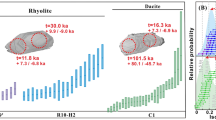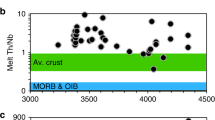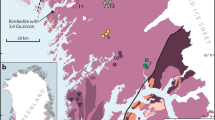Abstract
Zircon is a common mineral in continental crustal rocks. As it is not easily altered in processes such as erosion or transport, this mineral is often used in the reconstruction of geological processes such as the formation and evolution of the continents. Zircon can also survive under conditions of the Earth’s mantle, and rare cases of zircons crystallizing in the mantle significantly before their entrainment into magma and eruption to the surface have been reported1,2,3. Here we analyse the isotopic and trace element compositions of large zircons of gem quality from the Eger rift, Bohemian massif, and find that they are derived from the mantle. (U–Th)/He analyses suggest that the zircons as well as their host basalts erupted between 29 and 24 million years ago, but fragments from the same xenocrysts reveal U–Pb ages between 51 and 83 million years. We note a lack of older volcanism and of fragments from the lower crust, which suggests that crustal residence time before eruption is negligible and that most rock fragments found in similar basalts from adjacent volcanic fields equilibrated under mantle conditions. We conclude that a specific chemical environment in this part of the Earth’s upper mantle allowed the zircons to remain intact for about 20–60 million years.
This is a preview of subscription content, access via your institution
Access options
Subscribe to this journal
Receive 12 print issues and online access
$259.00 per year
only $21.58 per issue
Buy this article
- Purchase on Springer Link
- Instant access to full article PDF
Prices may be subject to local taxes which are calculated during checkout



Similar content being viewed by others
References
Visoná, D. et al. Zircon megacrysts from basalts of the Venetian Volcanic Province (NE Italy): U–Pb ages, oxygen isotopes and REE data. Lithos 94, 168–180 (2007).
Kinny, P. D. & Meyer, H. O. A. Zircons from the mantle: A new way to date old diamonds. J. Geol. 102, 475–481 (1994).
Belousova, E. A. et al. Two age populations of zircons from the Timber Creek kimberlites, Northern Territory, as determined by laser-ablation ICP-MS analysis. Aust. J. Earth Sci. 48, 757–765 (2001).
Mezger, K. & Krogstad, E. J. Interpretation of discordant U–Pb ages: An evaluation. J. Metamorphic Geol. 15, 127–140 (1997).
Rubatto, D. & Hermann, J. Zircon behaviour in deeply subducted rocks. Elements 3, 31–35 (2007).
Zartman, R. E. & Richardson, S. H. Evidence from kimberlitic zircon for a decreasing mantle Th/U since the Archean. Chem. Geol. 220, 263–283 (2005).
Belousova, E. A., Griffin, W. L. & Pearson, N. J. Trace element composition and cathodoluminescence properties of southern African kimberlitic zircons. Mineral. Mag. 62, 355–366 (1998).
Griffin, W. L. et al. The Hf isotope composition of cratonic mantle: LAM-MC-ICPMS analyses of zircon megacrysts in kimberlites. Geochim. Cosmochim. Acta 64, 133–147 (2000).
Page, F. Z. et al. Zircons from kimberlite: New insights from oxygen isotopes, trace elements, and Ti in zircon thermometry. Geochim. Cosmochim. Acta 71, 3887–3903 (2007).
Cherniak, D. J. & Watson, E. B. Pb diffusion in zircon. Chem. Geol. 172, 5–24 (2000).
Wilson, M. & Downes, H. in European Lithosphere Dynamics (eds Gee, D. G. & Stephenson, R. A.) 147–166 (Geol. Soc. London, Memoirs 32, 2006).
Ferry, J. M. & Watson, E. B. New thermodynamic models and revised calibrations for the Ti-in-zircon and Ti-in-rutile thermometers. Contrib. Mineral. Petrol. 154, 429–437 (2007).
Ferriss, E. D. A., Essene, E. J. & Becker, U. Computational study of the effect of pressure on the Ti-in-zircon geothermometer. Eur. J. Mineral. 20, 745–755 (2008).
Trail, D. et al. Constraints on Hadean zircon protoliths from oxygen isotopes, Ti- thermometry, and rare earth elements. Geochem. Geophys. Geosyst. 8, 1–22 (2007).
Monteleone, B. D. et al. Late Miocene-Pliocene eclogite facies metamorphism, D’Entrecasteaux Islands, SE Papua New Guinea. J. Metamorph. Geol. 25, 245–265 (2007).
Valley, J. W. in Zircon (eds Hanchar, J. M. & Hoskin, P. W. O.) 343–385 (Rev. Mineral. 53, 2003).
Yuan, H. L. et al. Simultaneous determinations of U–Pb age, Hf isotopes and trace element compositions of zircon by excimer laser-ablation quadrupole and multiple-collector ICP-MS. Chem. Geol. 247, 100–118 (2008).
Ulrych, J., Lloyd, F. E. & Balogh, K. Age relations and geochemical constraints of Cenozoic alkaline volcanic series W Bohemia: A review. GeoLines 15, 168–180 (2003).
Reiners, P. W., Spell, T. L., Nicolescu, S. & Zanetti, K. A. Zircon (U–Th)/He thermochronometry: He diffusion and comparisons with 40Ar/39Ar dating. Geochim. Cosmochim. Acta 68, 1857–1887 (2004).
Haase, K. M. & Renno, A. D. Variation of magma generation and mantle sources during continental rifting observed in Cenozoic lavas from the Eger rift, central Europe. Chem. Geol. 257, 192–202 (2008).
Geissler, W. H., Kämpf, H., Seifert, W. & Dulski, P. Petrological and seismic studies of the lithosphere in the earthquake swarm region Vogtland/NW Bohemia, central Europe. J. Volcanol. Geotherm. Res. 159, 33–69 (2007).
Witt-Eickschen, G. Upper mantle xenoliths from alkali basalts of the Vogelsberg, Germany: Implications for mantle upwelling and metasomatism. Eur. J. Mineral. 5, 361–376 (1993).
Witt-Eickschen, G. & Kramm, J. Mantle upwelling and metasomatism beneath central Europe: Geochemical and isotopic constraints from mantle xenoliths from the Rhön (Germany). J. Petrol. 38, 479–493 (1997).
Plomerová, J. et al. Upper mantle beneath the Eger rift (central Europe): Plume or asthenosphere upwelling? Geophys. J. Int. 169, 675–682 (2007).
Siebel, W. & Chen, F. Zircon Hf isotope perspective on the origin and evolution of granitic rocks from eastern Bavaria, SW Bohemian Massif. Int. J. Earth Sci. 10.1007/s00531-009-0442-4 (2009).
Goes, S., Spakman, W. & Bijwaard, H. A lower mantle source for central European volcanism. Science 286, 1928–1931 (1999).
Schmitt, A., Marks, M. A. W., Nesbor, H. D. & Markl, G. The onset and origin of differentiated Rhine Graben volcanism based on U–Pb ages and oxygen isotopic composition of zircon. Eur. J. Mineral. 19, 849–857 (2007).
Bouvier, A., Vervoort, J. D. & Patchett, P. J. The Lu–Hf and Sm–Nd isotopic composition of CHUR: Constraints from unequilibrated chondrites and implications for the bulk composition of terrestrial planets. Earth Planet. Sci. Lett. 273, 48–57 (2008).
Evans, N. J., Byrne, J. P., Keegan, J. T. & Dotter, L. E. Determination of uranium and thorium in zircon, apatite, and fluorite: Application to laser (U–Th)/He thermochronology. J. Anal. Chem. 60, 1159–1165 (2005).
McDonough, W. F. & Sun, S. S. The composition of the Earth. Chem. Geol. 120, 223–253 (1995).
Acknowledgements
Y. Hong-Lin, Northwest University, Xi’an, and W. Fang, CAS Beijing, assisted with Lu–Hf measurements, E. Reitter, Tübingen University, with Sm–Nd analyses, N. Evans and B. McDonald, Curtin University of Technology, Perth, with U and Th analyses. Ion microprobe work at UCLA was supported by a grant from the Instrumentation and Facilities Program, NSF. We thank J. C. Harvey (Caltech Pasadena, USA) for revising the English and I. Williams (ANU Canberra, Australia) for his valuable comments on an earlier version of the manuscript.
Author information
Authors and Affiliations
Contributions
S.M. and S.W. provided the zircons and valuable background information. Experiments were carried out by A.K.S. (oxygen, trace elements), F.C. (Lu–Hf), M.D. ((U–Th)/He), S.E. and W.S. (U–Pb, cathodoluminescence). W.S. designed the study. W.S. and A.K.S. interpreted the data and wrote the paper with substantial contribution made by M.D.
Corresponding author
Supplementary information
Supplementary Information
Supplementary Information (PDF 243 kb)
Rights and permissions
About this article
Cite this article
Siebel, W., Schmitt, A., Danišík, M. et al. Prolonged mantle residence of zircon xenocrysts from the western Eger rift. Nature Geosci 2, 886–890 (2009). https://doi.org/10.1038/ngeo695
Received:
Accepted:
Published:
Issue Date:
DOI: https://doi.org/10.1038/ngeo695
This article is cited by
-
Radiation damage allows identification of truly inherited zircon
Communications Earth & Environment (2022)
-
Himalayan zircons resurface in Sumatran arc volcanoes through sediment recycling
Communications Earth & Environment (2022)
-
Phase equilibrium modeling of zircon stability in mantle peridotite: Implication for crust-mantle interaction
Science China Earth Sciences (2022)
-
Long-lived dacitic magmatic systems and recharge dynamics in the Jemez Mountains volcanic field, western USA
Contributions to Mineralogy and Petrology (2022)
-
Detrital Zircon U–Pb Geochronology as an Indicator of Provenance in the Zhiluo Formation of the Western Ordos Basin, China
Arabian Journal for Science and Engineering (2021)



